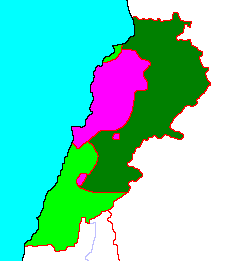Syrian occupation of Lebanon
The Syrian occupation of Lebanon (Arabic: الاحتلال السوري للبنان, French: Occupation syrienne du Liban) began in 1976, during the Lebanese Civil War, and ended in 30 April 2005 after the Cedar Revolution and several demonstrations in which most of the Lebanese people participated, and the withdrawal agreement was signed by President Bashar al-Assad and Saad Hariri, son of Rafic Hariri. All of these changes were a result the assassination of former Lebanese Prime Minister Rafic Hariri.
In January 1976, a Syrian proposal to restore the limits to the Palestinian guerrilla presence in Lebanon, which had been in place prior to the outbreak of the civil war, was welcomed by Maronites, but rejected by the Palestinian guerrillas.[1]
In October 1976, at a meeting of the Arab League, Syria accepted a ceasefire. The League ministers decided to expand an existing small Arab peacekeeping force in Lebanon, but it grew to be a large Arab Deterrent Force consisting almost entirely of Syrian troops. The Syrian military intervention was thus legitimized and received subsidies from the Arab League for its activities.[2]
In 1989, at the final accords of the civil war, two rival administrations were formed in Lebanon: a military one under Michel Aoun in East Beirut and a civilian one under Selim el-Hoss based in West Beirut; the latter gained the support of the Syrians. Aoun opposed the Syrian presence in Lebanon, citing the 1982 UN Security Council Resolution 520.[3] In the resulting "War of Liberation", which erupted in March 1989, Aoun's forces were defeated and he himself exiled from Lebanon. In 1991, a Treaty of "Brotherhood, Cooperation, and Coordination", signed between Lebanon and Syria, legitimized the Syrian military presence in Lebanon. It stipulated that Lebanon would not be made a threat to Syria's security and that Syria was responsible for protecting Lebanon from external threats. In September that same year, a Defense and Security Pact was enacted between the two countries.[4]
With the consequent adoption of UN Security Council Resolution 1559 and following the assassination of the Lebanese ex-premier Rafic Hariri in 2005, and the alleged involvement of Syria in his death, a public uprising called the Cedar Revolution had swept the country. Syria completed its full withdrawal from Lebanon on 30 April 2005.[5]
The Lebanese Civil War that began on 13 April 1975, was the backdrop against which the Syrian military presence in Lebanon was established.

